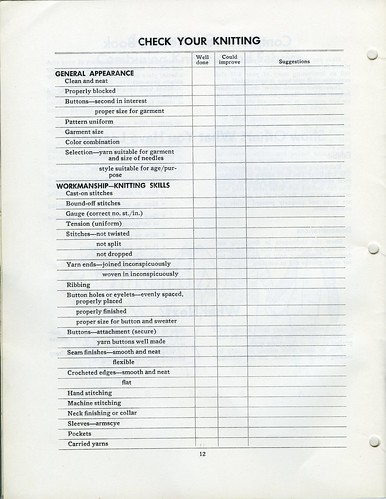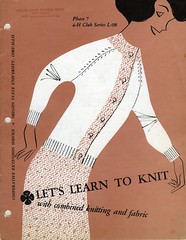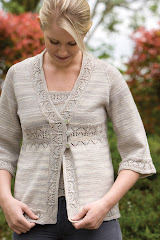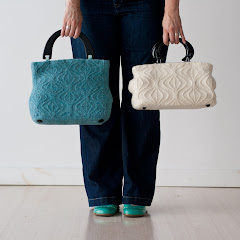The booklet whose cover is pictured here was a recent find of this nature--I came across it (and a couple of other gems from a few decades later, which I might also feature here eventually) in a bin of patterns and craft books at the charity shop in the little town in Washington State where my parents live. (You can see the Clallam County Extension Service stamp on the front cover there.) It's a sweet and serious package of information, and somewhat disingenuously named; they sneak quite a bit of general social-hygiene medicine in with that spoonful of craftsy-fun sugar. Just look at this list from page 1:
WHAT YOU WILL LEARN
1. To combine knitting with a fabric (all right, very good, just what one expects...)
2. To draft or chart a pattern for a knitted garment (yes, perfect...)
3. To knit in a hem (that's useful stuff...)
4. To shape shoulders by turning (also useful...)
5. To make knitted trims (ooh! what a treat!)
6. To develop more poise (what? wait a second...)
7. To select accessories (oh...OK...)
8. To take measurements (yeah, but...go back...what was that about poise?)
9. To share skills, interests, and abilities with others (um...sure...I guess)
Readers are firmly instructed to "Read this bulletin from cover to cover before you start your project," which means that before you even get to plan your combined-knitting-and-fabric project, you must dutifully absorb all of pages 2 and 3, which is headed "A More Charming You." There's advice--well, rules, really--for "Entering a room," "Sitting prettily," "Rules for pretty hands," and then strict guidelines for selecting and deploying gloves, handbags, hats, shoes, and hosiery. Dear me. The 4-H Knitting Advisory Committee seems pretty determined to make the combination of knitting and fabric the exclusive province of those young ladies who have already demonstrated they can hold a clutch purse at the proper angle and won't spoil their nice entrance by looking down at a chair as they sit in it. The ass-kicker? The last page of the book is a self-assessment form, where you're encouraged to note which aspects of your knitting are "well done" or "could improve" and make suggestions for yourself. The best criterion on the list, I think, is "Selection - style suitable for age/purpose." I tell you, I've definitely seen some "could improves" for that one out there, haven't you? This checklist is the best part; it's actually why I decided to buy the book.

It all makes me extra-grateful for my knitting group, which I think is entirely composed of ladies and gents who do look down at their chairs as they sit--there might be someone's knitting needles there, after all!--and which tends to get extremely salty, conversation-wise. (Salty language isn't even covered in this booklet.) We do all have good shoes, though! Knitting--and learning to knit--has obviously changed a lot in the last few years, as a single glance at the "learn to knit" section of the bookstore shelves will tell you. Just uttering the phrase "stitch and bitch" would probably have got you chucked out of the 4-H Knitting Advisory Committee back in the day. Much as I like vintage styles and "Mad Men" and all that, I'm glad this booklet and the attitudes in it wasn't part of my introduction to knitting. I do know people whose grannies or aunties taught them to knit as part of a general pursuit of appropriate and ladylike activities, and were very stern about how things ought to be done, but I wasn't one of them.
They really don't make them like they used to, but that's not always cause for regret.









No comments:
Post a Comment